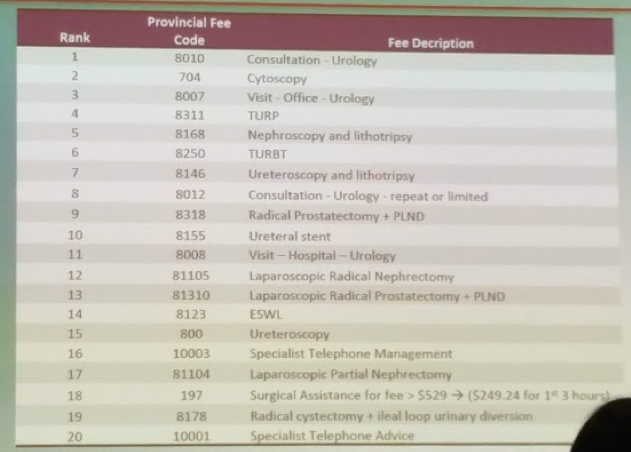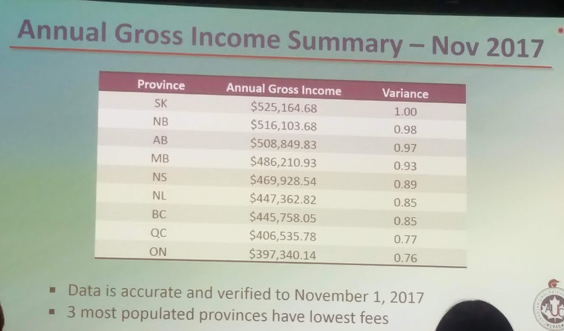The first part was specifically an evaluation of the graduating residents between 2014-2016 to assess their challenges regarding finding employment. The basis for the evaluation was the following:
1. Concern that Canadian Urology residency may be training too many residents
2. In the 2000’s, # of residency spots ballooned from 15 to mid-30’s
3. Despite this doubling of residents graduated, there doesn’t appear to be more jobs
- 37 urologists gave up their licenses during 2013-2015
- # of practicing urologists has remained steady ~680-690 in this time frame
4. Urology is a resource-intensive specialty – lack of hospital resources is perceived as a barrier to employment
5. CIHI demonstrates a decrease in health care funding ~0.1% per year
To address this, they completed 88 question multi-faceted survey of all graduates from 2014-2016 – open-ended, binary / Likert scale questions. The response rate was moderate: 50 of 100 eligible residents responded. There were responders from all 3 years and from all 12 major urology programs. Below, I will highlight some of the key findings that he reviewed:
1. Frustration and concern is palpable regarding the shortage of jobs
2. The majority believe there is overtraining of residents
3. Competency – most residents feel they are competently trained in general urology, endourology, and laparoscopy (>85%). Pediatrics was lagging as expected.
4. 85% were planning on doing a fellowship (primarily oncology or robotics/MIS)
- Primarily in the US or Canada
- The main reason was to compete for a better job (83%); less commonly for interest (63%) or feeling uncomfortable with skills (12%)
5. Employment
- 28% were offered staff positions before graduating from residency
- 57% were employed as staff urologist (though 30% of those were locums)
- The majority wanted to stay in Canada and most did (88%)
- He commented on how much they wanted to work vs. how much they were working – most were satisfied with how much they were working (88% 5+ days/week)
- He reviewed salary of those employed and most earn between 300-500K/year
6. Choosing employment
- Location is one of the major factors
- Resources available is another major factor
7. The majority felt that Canadian residency programs should graduate fewer residents – most felt the total number should reduce by 1-5 (48%) or 5+ (38%)
To address this, they are working on creating a CUA job finding board (and to make the hiring process more transparent). They are also exploring alternative work models (part-time, non-surgical practice, mentorship models).
In the second part, he shifted gears and examined the differences in income and remuneration amongst provinces. Urologists in all the provinces work fee for service – but each province sets the fees for procedures separately.
- As specialties are competing for funds (it’s a zero-sum game), when going into arbitration over prices / fee schedule, its important to have strong data regarding interprovincial disparities.
- This model does not include private insurance, uninsured, etc. Nor does it include taxes, salary paid to support staff, etc. It is purely gross income.
- The top 20 fee codes were as follows:

- Notable interprovincial disparities were identified
- Nova Scotia consistently had some of the lowest oncology fees and disproportionately high stone fees (URS+lithotripsy paid more than a radical prostatectomy +LND and lap partial nephrectomy!)
- Ontario – Radical cystectomy and diversion fees were 2nd lowest in the country (after NS), and was almost the same as a radical prostatectomy
- Annual gross income

- The 3 most populous provinces make the least money
- This assumes a similar practice across the country
Despite the limitations of the analysis, it highlights the discrepancies between provinces and can be used to arbitrate with the provincial government.
Presented by: Omar Nazif, MD, Urologist, Surrey Memorial Hospital — Surrey, Canada, University of British Columbia, Vancouver, BC
Written By: Thenappan Chandrasekar, MD, Clinical Fellow, University of Toronto Twitter: @tchandra_uromd at the 73rd Canadian Urological Association Annual Meeting - June 23 - 26, 2018 - Halifax, Nova Scotia